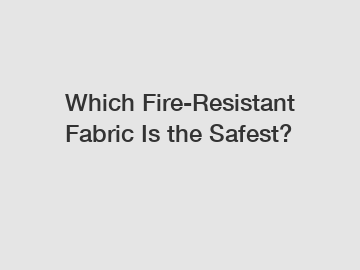Which Fire-Resistant Fabric Is the Safest?
Which Fire-Resistant Fabric Is the Safest?
When it comes to safety, there is no compromise. This is especially true when it comes to protecting ourselves from fire hazards. Fire-resistant fabrics are crucial in various industries, including firefighting, military operations, and even everyday work environments where the risk of fire is high. With so many options available in the market, determining the safest fire-resistant fabric can be a daunting task. However, by considering certain factors and understanding the different types of fire-resistant fabrics, you can make an informed decision to ensure optimal safety in hazardous situations.
Understanding Fire-Resistant Fabrics.

Fire-resistant fabrics are specially designed textiles that are treated with chemicals to inhibit fire spread. These fabrics are typically used in protective clothing and other applications where individuals may be exposed to flames or extreme heat. Fire-resistant fabrics can be divided into two main categories: inherent and treated.
Inherent Fire-Resistant Fabrics.
Inherent fire-resistant fabrics are made from fibers that are naturally flame-resistant. These fabrics do not require any additional chemical treatment to offer protection against fire. Aramid fibers, such as Nomex and Kevlar, are examples of inherent fire-resistant fabrics. Aramid fibers have excellent flame resistance properties and are known for their high strength and durability. They do not melt or drip when exposed to flames, which makes them ideal for flame-resistant garments and equipment.
Treated Fire-Resistant Fabrics.
Treated fire-resistant fabrics, on the other hand, are made from fibers that are treated with flame-retardant chemicals. Cotton and polyester fabrics are commonly treated to enhance their fire-resistant properties. Treated fabrics are often more cost-effective compared to inherent fire-resistant fabrics. However, they may lose their flame-resistant properties over time and with repeated laundering. Therefore, it is essential to follow proper care instructions to maintain their effectiveness.
Determining Safety Factors.
When evaluating the safety of fire-resistant fabrics, several factors should be considered. These include flame resistance, heat insulation, and comfort. Flame resistance refers to the fabric's ability to resist catching fire and to self-extinguish when exposed to flames. Heat insulation measures how effectively the fabric can protect the wearer from burns and heat transmission. Comfort incorporates factors such as breathability, flexibility, and weight of the fabric, which can affect the wearer's overall comfort and mobility.
Selecting the Safest Option.
The choice of the safest fire-resistant fabric depends on the specific requirements of the intended application. In general, inherent fire-resistant fabrics, such as aramid fibers, offer superior protection compared to treated fabrics. They provide better flame resistance, thermal protection, and durability. However, treated fabrics can still offer adequate protection and may be a more budget-friendly option for certain industries.
It is crucial to consult with experts in the field to ensure the fabric chosen meets the required safety standards. Manufacturers and suppliers of fire-resistant fabrics can provide valuable guidance and assistance in selecting the most suitable fabric for a particular application.
Conclusion.
Safety should always be a top priority, especially when it comes to protecting ourselves from fire hazards. Choosing the right fire-resistant fabric is essential to ensure optimal safety in potentially dangerous situations. By understanding the different types of fire-resistant fabrics and considering factors such as flame resistance, heat insulation, and comfort, you can make an informed decision. Whether you opt for inherent fire-resistant fabrics like aramid fibers or treated fabrics, consulting with experts in the field will help ensure you select the safest option for your specific needs.
For further information or assistance in selecting the right fire-resistant fabric, please do not hesitate to contact us.
If you want to learn more, please visit our website Fr Fabric Suppliers, fabric fire protection, Fire Resistant Fabrics Industry.

Comments
0